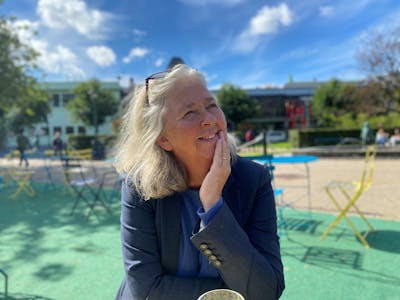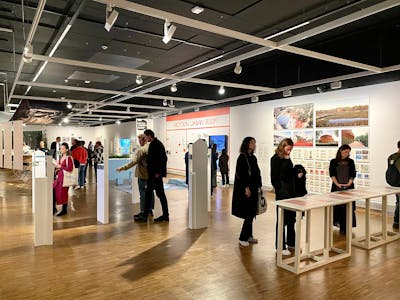Towards a Nordic Neighbourhood Lab
How can cities take action to support more diverse and sustainable neighbourhood developments?

Director Christian Pagh adressing the Nordic Triennale community during the Neighbourhood Camp workshop held at DOGA this spring. Photo: Kristoffer Pahle.
Oslo Architecture Triennale brings together architects, design institutions, developers and community actors to develop more cohesive, socially fair and culturally diverse neighbourhoods.

Copenhagen's City Architect Camilla van Deurs was one of the jury members. Photo: Nils Hartmann
As a response to the growing challenges in existing and developing urban areas, the Triennale has formed the Nordic Neighbourhood Lab as an interdisciplinary platform and a way of working together with different neighbourhood stakeholders – exploring, experimenting, discussing.
As part of the Lab’s work we are bringing together City Architects in the Nordic cities along with design institutions and culture & community actors, to share knowledge and build new competency.
"Urban spaces should be inviting and generous in the way they approach the city."
Camilla van Deurs, City Architect of Copenhagen
The ambition is to share practical understanding on how to encourage diverse cultural development and high-quality public functions in the planning and transformation of Nordic cities – on a neighbourhood scale.
We aspire to contribute to the cities’ and institutions’ abilities to plan for – and with – diverse communities, and to bring cultural and artistic perspectives and resources into the urban development processes. We want to empower stakeholders to take collective action on the scale of the neighbourhood and develop more shared solutions – in the nexus between architecture, design, cultural planning and policy making.

Stockholm's City Architect, Torleif Falk. Photo: Jonas Malmström.
Background and context
There is a need to take on the challenges of rethinking how we organise our cities with an interdisciplinary approach and mindset informed by cultural, artistic and design practices. Though the partner cities in the Nordic Network of Neighbourhood Culture have their differences, there are common challenges:
- Lack of cultural and social infrastructure, meeting places and sense of place in many new urban areas
- An interest from the public sector to engage the public and the urban communities to a larger degree and to pursue more culture-savvy approaches to urban development
- A desire to find concrete, community-oriented alternatives to an investor- and developer driven urban development

Bergen's City Architect, Maria Molden.
The lab explores questions such as
how can cities plan for more diverse, inclusive neighbourhood culture, empower local engagement and help realise more socially sustainable urban solutions
what practical initiatives and modes of operation can be put in place to promote a more socially diverse, just and culture-conscious urban development?
how can city planning authorities redesign rigid planning processes, engage citizens in better ways and harvest social and cultural synergies in neighbourhoods?
"It's all about the elementary features of the already existing elements: How is the building, how does it interact with the street, what is the relation between inside and outside? And how do we create meeting places - places for the coincidential meetings?
Maria Molden, City Architect of Bergen
In March 2022 the Nordic community came together to discuss neighbourhood questions in the Nordic Neighbourhood Camp – a two day intensive event in Oslo, combining lectures by distinguished speakers with focused workshops. Reflections and suggestions from the Camp were delivered to representatives from Oslo’s urban development politicians.

Camp in action. Katja Lindroos, CEO of Helsinki-based Urban Practice and co-founder of Nordic CityMaking Week.
The Nordic Neighbourhood Camp was generously supported by FINNO and Nordic Culture Fund.


